Competency Guidelines for Academic Preparation of Baccalaureate ...
Competency Guidelines for Academic Preparation of Baccalaureate ...
Competency Guidelines for Academic Preparation of Baccalaureate ...
You also want an ePaper? Increase the reach of your titles
YUMPU automatically turns print PDFs into web optimized ePapers that Google loves.
<strong>Competency</strong> <strong>Guidelines</strong> <strong>for</strong> <strong>Academic</strong> <strong>Preparation</strong> <strong>of</strong> <strong>Baccalaureate</strong> <br />
Nurses Caring <strong>for</strong> Patients with Wounds <br />
1. Demonstrates knowledge <strong>of</strong> <br />
1.1 Anatomy and physiology <strong>of</strong> the skin <br />
1.2 Physiology <strong>of</strong> normal wound healing <br />
1.3 Pathophysiology <strong>of</strong> chronic wounds <br />
1.4 Risk assessment strategies <strong>of</strong> factors impairing wound <br />
healing <br />
1.5 Signs and symptoms <strong>of</strong> wound infection <br />
1.6 Evidence based principles related to wound care <br />
1.7 Psychosocial aspects <strong>of</strong> acute and chronic wounds <br />
2. Per<strong>for</strong>ms a comprehensive assessment <strong>of</strong> the individual <br />
including risk factors <strong>for</strong> the development <strong>of</strong> chronic wounds and <br />
delayed healing (e.g., ability to mobilize, nutritional status, <br />
infection). <br />
3. Demonstrates principles <strong>of</strong> wound bed preparation including <br />
The TIME acronym <strong>of</strong> Tissue, Infection, Moisture and Edges <strong>of</strong> the <br />
wound <strong>for</strong> the management <strong>of</strong> the wound. <br />
4. Per<strong>for</strong>ms accurate documentation <strong>of</strong> wound assessment and <br />
management strategies. <br />
5. Identify key management strategies (e.g., dressing selection, <br />
cleansing, topical, pressure relief) rather than extensive strategies. <br />
6. Classifies major wound types appropriately: pressure, venous, <br />
diabetic, arterial, full-‐-‐-‐thickness, and partial-‐-‐-‐thickness. <br />
7. Uses current evidence based research as the basis <strong>for</strong> wound <br />
care.
8. Participates in developing patient focused interdisciplinary plans <br />
<strong>of</strong> care including goals and expected outcomes. <br />
9. Assists individuals and caregivers to make in<strong>for</strong>med health care <br />
decisions related to wound care. <br />
10. Monitors and evaluates wound treatment outcomes.(e.g., <br />
methods <strong>of</strong> measuring healing) <br />
11. Develops strategies <strong>for</strong> follow up <strong>for</strong> evaluation <strong>of</strong> treatment <br />
plan/prevention <strong>of</strong> recurrence. <br />
Adapted from: <br />
Australian Nursing and Midwifery Council, National <strong>Competency</strong> <br />
standards <strong>for</strong> the Registered Nurse Standards <strong>for</strong> Wound <br />
Management 1st edition (2002). Australian Wound Management <br />
Association, Inc. <br />
Review Participants: <br />
Joyce K. Stechmiller, University <strong>of</strong> Florida; Rita Franz, Dean, School <strong>of</strong> Nursing University <br />
<strong>of</strong> Iowa; Sue Gardner, University <strong>of</strong> Iowa; Elizabeth Ayello, Excelsior College; Linda <br />
Cowan, NF-‐-‐-‐SG VHS; Karen Zulkowski, Montana State College; Nicola Waters Mount <br />
Royal University,Calgary, Alberta;


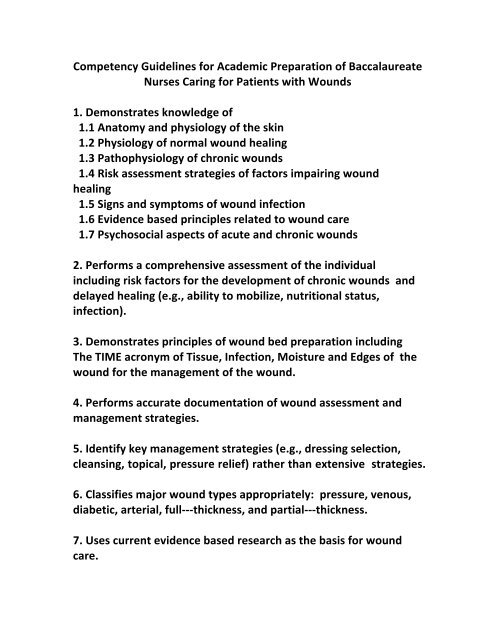

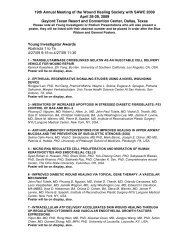

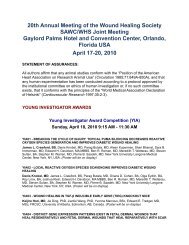
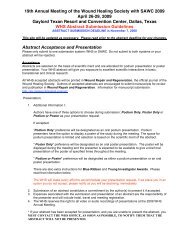
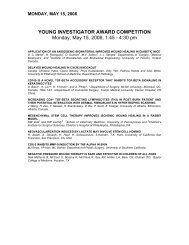




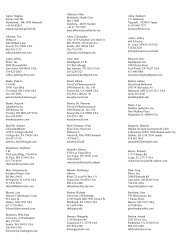
![2010 Abstracts-pah[2] - Wound Healing Society](https://img.yumpu.com/3748463/1/190x245/2010-abstracts-pah2-wound-healing-society.jpg?quality=85)